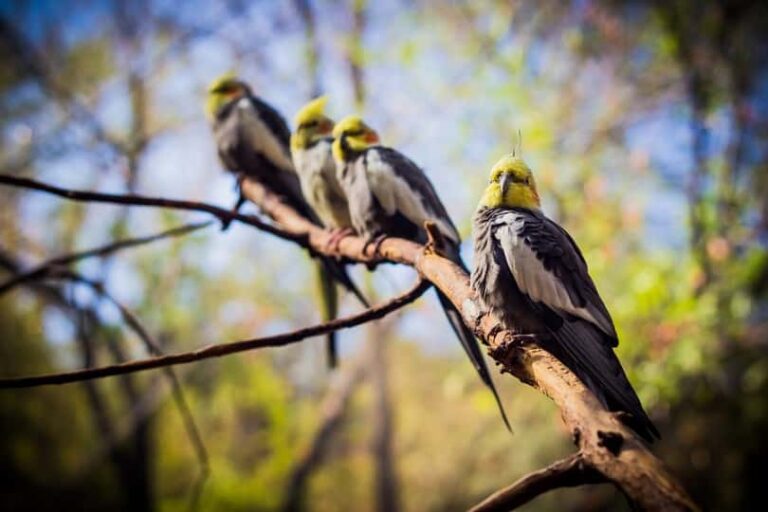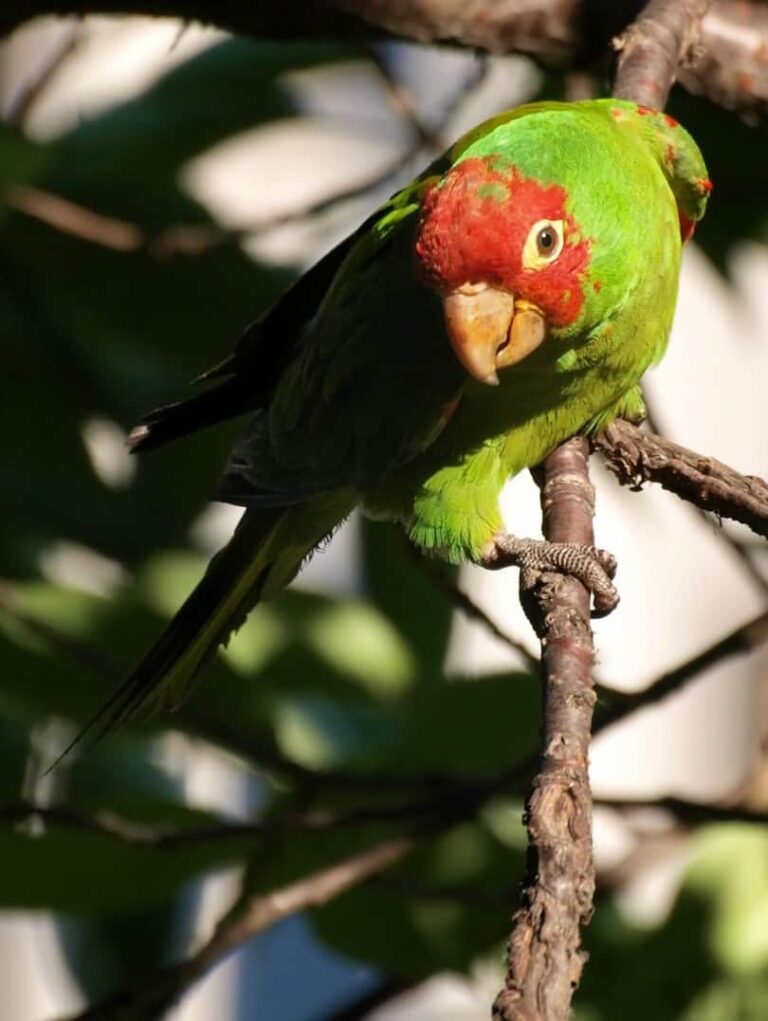Lories & Lorikeets
Lories and Lorikeets belong to the tribe called “Lorini;” the size of these birds is tiny to average. They are parrots that dwell in trees and are peculiar on account of their tongues tipped like a brush that helps them in sucking nectar from different kinds of soft texture fruits like berries and flowers. The Lories and Lorikeets configure a group called “Monophyletic” in the Psittacidae family of parrots. By tradition, the Lories and Lorikeets were believed to belong to a detached subordinate group (Loriinae) which was from another subgroup (Psittacinae) on the basis of their particular individuality. Scientifically, these two birds are not different – but the Lorikeets have tails that are longer than that of Lories. There exist around 55 different varieties of these birds; however, 12 varieties of these birds are reared as pets. The Rainbow Lorie is well-liked by many.
| Description | lowlands |
| Name: | Lorie (Trichoglossus) |
| Origin: | New Guinea, Australia and Indonesia |
| Size: | Depending on their variety. 10 to 12 inches |
| Color Differences | The varieties range in different colors from green to Red, black and blue. The feathers on a good number of them are of several colors. |
| Average Cost | $300-900 |
| Lifespan | They survive up to 20 years |
| Noise: | Comparatively, they have a low voice and are silent, hence fairly good to dwell in your apartment. |

Qualities
They are playful, gymnastic, inquisitive, lively, fond of bathing, requires particular feed and caring, have brush-like-tongues, sociable, vigorous, extroverts, comedians, fond of hanging headlong down, hostile toward other kinds of birds, appears to love all (they don’t have attachment to just a single person).
Abilities
They have the ability of speaking, possess a good number of vocabulary (they have a clear and highly pitched voice), they whistle very well
Habitat
They dwell in the islands, mangroves, Forests, woods of the mountains and plantations
Reproduction
It is easy to breed these Lorikeets. Even though the sexual interaction is not easy for them, once they are settled, their nesting becomes normal for them. When a pair mates, it is exciting to watch them; this raises the moods of the others. From March up to September is their breeding period.
Their nature of courtship is similar to the other Lories. The pair hugs each other, flutter their wings and dance, wiggling their whole bodies to and fro, with one bird moving its head around the other. They narrow their pupils and on the whole make twittering and whistling calls.
Each clutch comprises of 2 eggs and at times 3. Just at one time all the 3 are hatched, but normally, only two of the three get fertile, the third one dying after eight days as it was not fully developed in the initial stage.. The female continuously incubates the eggs. The male pays visits to the nest, many times a day. The number of days the young takes to hatch is from 26 to 28. In the initial stage, the young one is colored white, which after some time changes to a gray tint. The first feather begins to appear after the third week and the eyes gradually open after the chicks have grown to an age of 13 days.
Types of Lories and Lorikeets
As mentioned above, these 55 different types of Lories and Lorikeets have different appearances and sizes. Following are the names of some species of Lories and Lorikeets-:
Red Lory
The Red Lory, called Eos Rubric or Eos Bornea, is Parrot species belonging to the family Psittaculidae. Among the Lories kept in captivity, in popularity, the Red Lory is second only to the Rainbow Lorikeet in the commercial sense.
Black Lory
These birds have a black plumage. They grow about 32 cm and weigh around 230 to 260 grams.
Black Capped Lory
These birds have predominantly a red body and black forehead. They attain a height of 31cm and weigh between 200 and 260g.
Cardinal Lory
These birds have a red plumage and the bill is also red at the top and black at the bottom. They grow up to 31 cm and weigh 175 to 215g.
Fairy Lorikeet
These birds have a bright green colored back and orange bill. They grow about 18 cm and they attain a weight of 23 to 34 g.
Goldie’s Lorikeet
These birds generally have greenish-yellow body and red crown. They grow only up to 19 cm and attain a weight of 45 to 57g.
Ornate Lorikeet
These birds have a unique purple-/blue colored crown and red colored cheek. The upper part of the body is green. They attain a height of 25 cm and weight around 110g.
Rainbow Lorikeet (The most commercially Reared Lorikeet)
This species of birds is very popular among the pet lovers. Its body is a combination of various colors like brown, red, blue, green and yellow. It has a height of 26 cm and a weight of 100 to 157 g.
Growing At Home
Cage
A roomy cage is required like 36″ H x 48″ L x 24″ W unless the bird is to be let out for extended periods. Many birds can spend most of their time on a play pen or parrot perch. A cage guard is a good idea since their droppings are a sticky fluid which ends up outside the cage. Lories and Lorikeets acclimate
Provide them with a spacious cage of 36”x48”x24” L x B x W, unless you consider allowing it out of the cage for long periods. Several birds enjoy throughout the day playing on the parrot perch and in the play pen. It is good to have a cage guard; this will guard the droppings that are sticky, falling out of the cage. Lorikeets and Lories adapt easily
Maintain the house temperature to an average and don’t exceed 80oF; severe changes in temperature are harmful to them. Place the cage above the floor, where there is plenty of light, and far from drafts. Keep fresh fruits for only an hour, and after that, replace them with a container containing Lorikeet Dry Mix. Provide them drinking water in a container that is kept at a height; add fruit nectar of 20 ml in a drinking bottle that allows the water to flow by gravity. Establish new local branches with flowers (for example Grevilla) within the cage for giving them the opportunity to forage during the day.
Food
Lorikeets and Lories feed on nectar, pollen and fruits. Discard all the uneaten food, which otherwise becomes a slurry so that your Lories and Lorikeets do not eat the unhealthy slurry and get sick. These birds need a “Special” diet, because, their gizzard is not capable of breaking up and digesting the nutrients to ingest the food (like the seed pellet eating parrots). The best food for the Lorie seems to be Nekton (for the juvenile Lories), which is very costly. Besides, you can also try www.loryfood.com. , a food that is produced and marketed by Linda Blessing; this could be the best for your Lories and Lorikeets
The ingredients are: millet flour, sucrose sugar, Fructose fruit sugar, brown rice flour, soy protein isolate, dried apples, bee pollen, dried hibiscus flowers, calcium citrate, dried rose petals, dried bell peppers, powdered carrots, dried spearmint, coconut, powdered alfalfa, nutritional yeast powder, Spirulina, milk thistle seed powder, barberry powder, eucalyptus leaf, papaya leaf powder, dandelion leaf powder, barley grass powder, powdered Aloe Vera, Hentonite clay powder, wheat grass powder, multi-mineral powder, xanthan gum and ground freeze dried blue-berries.
Care
A vital area concerning the nurturing of your pet bird and increasing the hidden qualities of your buddies is to take them to a vet for a yearly check on its health, since only a healthy bird would respond with full vigor to your love or attention in the course of your training. Birds are good at concealing their sickness, as such, in the course of examining the health of the birds, you need a microscopic test on its droppings (and perhaps many other tests). Good veterinary doctors, in the process of examining the birds, will also evaluate the improvement of the bird’s intelligence. The vital part is the yearly examination of the health of the bird, which permits you to schedule a program in accordance with the personal needs of the birds. Give your Lorikeets every day, a fresh branch or special device when they are housed in a cage so that they can forage. In the wild, in Australia, the majority of the Lories and Lorikeets and other big parrots take pleasure in picking buds and nuts of the indigenous trees and bushes like tea trees, bottle brush trees, Pittosporum, and the likes. Try to take your birds outside from mid noon to late in the noon. Release your bird from its cage by requesting it to hop onto your finger, and further permit it to fly under your supervision. Sing along with it, play games or keep dancing with your bird while giving its evening feed, since this is the time when Lorikeets learn naturally, Pet Lorikeets respond quickly at this time to clicker training if you give them grape slithers as a treat for their training
Bath
Your Lories and Lorikeets develop a good skin condition as well as fine feathers if you give them a routine shower or bath. Once your Lories and Lorikeets are accustomed to being bathed, there is chance that it enjoys drenching with water. Certain birds take pleasure playing in the sink and also delight when they are kept for a time under running water that is warm. Be careful in avoiding water entering the ears, eyes and nostrils of your Lories and Lorikeets. By giving your pets, Lorikeets and Lories proper food, they will grow into healthy and hardy birds.
Nectar has a high content of calories and sugar. Wild Lorikeets enjoy this food, but this leads to obesity of pet birds if you feed them nectar in excess, without enough exercise.
Lories are liable to disease caused by excess of iron in their food, this is called Hemochromatosis. When compared to several parrots, these Lorries consume more water, as such; Lorikeets and Lories are sensitive to several drugs and must be medicated with care through an experienced avian veterinarian.

Having discovered a fondness for insects while pursuing her degree in Biology, Randi Jones was quite bugged to know that people usually dismissed these little creatures as “creepy-crawlies”.







